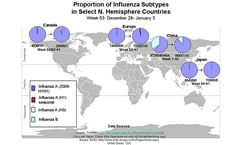Content on this page was developed during the 2009-2010 H1N1 pandemic and has not been updated.
- The H1N1 virus that caused that pandemic is now a regular human flu virus and continues to circulate seasonally worldwide.
- The English language content on this website is being archived for historic and reference purposes only.
- For current, updated information on seasonal flu, including information about H1N1, see the CDC Seasonal Flu website.
2009 H1N1 Flu: International Situation Update
January 22, 2010, 5:30 PM ET
- This report provides an update to the international pandemic influenza 2009 H1N1situation as of January 22, 2010. The World Health Organization (WHO) continues to report laboratory-confirmed 2009 H1N1 flu cases and deaths on its Web page. These laboratory-confirmed cases represent a substantial underestimation of total cases in the world, as most countries are focusing testing only on people with severe illness. The 2009 H1N1 influenza virus continues to be the dominant influenza virus in circulation in the world. For the most recent period reported by WHO FluNet, January 3, 2010 to January 9, 2010, 74.6% of influenza positive specimens were typed as influenza A and 18.2% as influenza B. Out of all subtyped influenza A viruses, 97.2% were 2009 H1N1 positive.
- In temperate regions of the Southern Hemisphere, sporadic cases of 2009 H1N1 continue to be reported but no substantial increases in influenza activity have been observed. In the temperate and tropical regions of the Americas, H1N1 activity continues to decrease or remain low. In North Africa, limited data suggests 2009 H1N1 transmission remains geographically widespread and active, but has likely recently peaked in most areas. Transmission of 2009 H1N1 also continues to be geographically widespread across parts of Western, Central, and Southeastern Europe, and East- and West- Asia, but overall rates appear to be low or declining.
Selected Highlights
- The 2009 H1N1 influenza virus is the predominant influenza virus in circulation worldwide.
- According to WHO, the majority of 2009 H1N1 influenza isolates tested worldwide remain sensitive to oseltamivir, an antiviral medicine used to treat influenza disease. To date, 206 cases of oseltamivir-resistant 2009 H1N1 have been reported – 54 of these were detected in the United States.
International Resources for 2009 H1N1 Information
Health Organizations
- World Health Organization (WHO)
- ECDC (European Centre for Disease Prevention and Control)
- H2P (Humanitarian Pandemic Preparedness)
- Public Health Agency of Canada
World Health Organization (WHO) Regional Offices
- AFRO (WHO Regional Office for Africa)
- AMRO (WHO Regional Office for the Americas) / PAHO (Pan American Health Organization)
- EMRO (WHO Regional Office for the Eastern Mediterranean)
- EURO (WHO Regional Office for Europe)
- SEARO (WHO Regional Office for South-East Asia)
- WPRO (WHO Regional Office for the Western Pacific)
Travel and 2009 H1N1 Flu
Human cases of 2009 H1N1 flu virus infection have been identified in the United States and several countries around the world. For information on 2009 H1N1 flu and travel, see the CDC H1N1 Flu and Travel website.
Reports and Publications
- White House Report on 2009 H1N1 in the Southern Hemisphere
Issued August 2009 – This White House report was prepared by the Department of Health and Human Services (HHS) in coordination with the Office of the Director for National Intelligence (ODNI) and the Department of State (Dos) and describes the characteristics and impact of 2009 H1N1 influenza A virus in the Southern Hemisphere. - ECDC Interim Risk Assessment Influenza A (H1N1) 2009 Pandemic
Issued July 30, 2009 - This document provides an interim risk assessment of novel H1N1 flu in Europe prepared by ECDC. - World Health Organization Weekly Epidemiological record – Issued July 24, 2009
This document by WHO provides updates on the international novel H1N1 flu situation. - MMWR – Update: Novel Influenza A (H1N1) Virus Infection – Mexico, March-May, 2009 – Issued June 5, 2009 / Vol. 58 / No. 21.
This Morbidity and Mortality Weekly Report describes the novel influenza A (H1N1) outbreak in Mexico from March-May, 2009. - MMWR – Update: Novel Influenza A (H1N1) Virus Infections – Worldwide, May 6, 2009 – Issued May 8, 2009 / Vol. 58 / No. 17.
This Morbidity and Mortality Weekly Report describes worldwide novel influenza A (H1N1) infections as of May 6, 2009.
Get email updates
To receive weekly email updates about this site, enter your email address:
Contact Us:
- Centers for Disease Control and Prevention
1600 Clifton Rd
Atlanta, GA 30333 - 800-CDC-INFO
(800-232-4636)
TTY: (888) 232-6348 - Contact CDC-INFO



